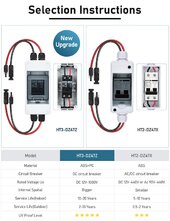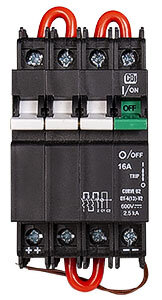GXMnow
Solar Wizard
- Joined
- Jul 17, 2020
- Messages
- 2,717
Here is the line I used for my DC breakersWhat breaker do you recommend?
They are only CE rated not UL, but CE is not bad, just might not be as strict of abuse testing as UL. And I went with the 400 volt DC rated and my system will never see over 150 volt. They also have a 1,000 volt rated line if you go to a 400 volt series array. I was very surprised to see these fairly small breakers rated to 400 volts of DC while not being polarity sensitive. Many DC rated breakers wan the current going a specific direction as they use magnets to help blow any arc out of the switch gap. Since these don't car about polarity, they must use distance and a barrier to break the arc. I have only tried them out to 100 volts so far, and they turn off clean with no issue. I intentionally wanted ones that did not care about polarity for the 125 amps battery breakers as the current could be flowing either direction depending on if it is charging or discharging. I have 2 batteries and a breaker on each one. If the current is perfectly balance, that would be 250 amps, but my inverter will only ever pull about 140 amps and my max charge current only hits about 90 amps.
There is not really much of a safety difference here. Yes, you can get a shock a little more easily at 48 volts, and I did get one off my system, but you really should be taking the same safety precautions. I got shocked while fixing a balance lead in my battery bank, my sweaty arm brushed a bus bar and I felt my whole arm tingle pretty hard. I always wear low voltage rubber gloves now when I am inside the battery cabinet. Had I been wearing long sleeves or the gloves I never would have felt a thing. With 24 volts, you are dealing with double the current, and that can be as big of an issue.Yea I'm looking hard at 48V it's just a safety thing for now.
My dumb, basic rule of thumb is simple. Keep the normal steady long term current under 100 amps. So a 12 volt system is good up to 1,200 watts, 24 volts to 2,400 watts, and 48 volts to 4,800 watts. A short term load to double those is okay. Many people do push far higher, but for me, this works well. My system is "48 volts" but really 50 to 58 volts at the battery. I run all my house loads on it and I still rarely see it hit 100 amps. Right now my whole house is only using about 850 watts from the battery bank, and that's only about 15 amps with the battery at 56.4 volts. But when my Central A/C kicks on, I will see another 4,000 watts. If the microwave is also running, that is another 1,800 watts. It can add up fast.






